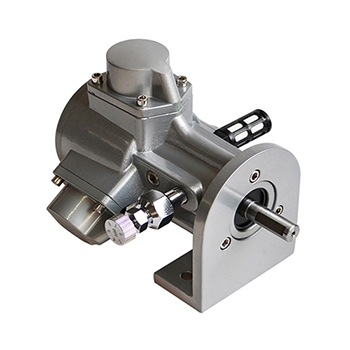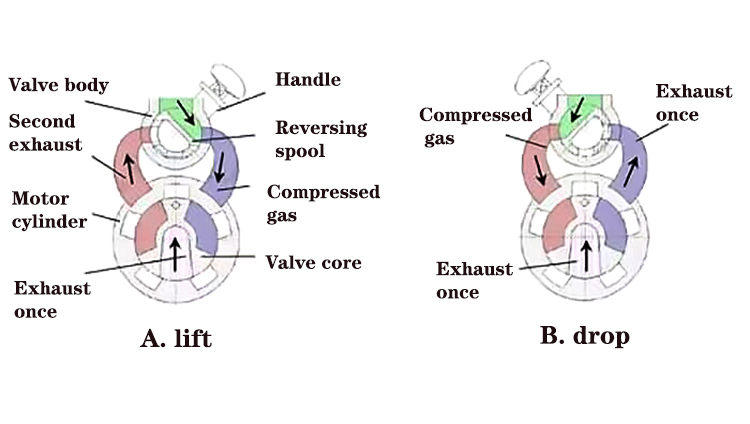What is Piston Air Motor Working Principle?
Vane, piston, and gear air motors are widely used in pneumatic transmission. The piston air motor is an air motor that converts the linear motion of several pistons into rotary motion through a crank or swash plate. Piston air motors are mainly used in mining machinery, and can also be used as drive motors for conveyor belts, etc. Only by deeply studying the working principle of the piston air motor, can we use the air motor more skillfully to make life more convenient. Next, we will introduce you to the knowledge of how it works.
Working principle of piston air motor
The air motor is mainly composed of a motor case, a connecting rod, a crankshaft, a piston, a cylinder, and a gas distribution valve. The piston air motor compresses the air to enter the air distribution valve core to make the valve core rotate, and at the same time, with the help of the rotation of the air distribution valve core, the air is sent to the surrounding pneumatic cylinders in sequence. Finally, the expansion of compressed air in the cylinder drives the rotation of the piston connecting rod and crankshaft.
When the piston is pushed to the "bottom dead center", the gas distribution valve core also turns to the first exhaust position simultaneously. The expanded gas will be directly discharged from the cylinder through the exhaust hole of the valve, and all the remaining gas in the piston pneumatic cylinder will be discharged from the exhaust pipe of the valve. Through such a reciprocating cycle, the compressed air kinetic energy can make the crankshaft rotate continuously.
Characteristics of piston air motor
Although various types of air motors have different structures and working principles, most piston air motors have the following characteristics:
- The speed regulation is possible. As long as the opening of the intake valve or exhaust valve is controlled, that is to say, the flow rate of compressed air is controlled, the output power and speed of the motor can be adjusted, thereby achieving the purpose of adjusting the speed and power.
- It can rotate forward and reverse. Most air motors can change the intake and exhaust directions of the motor by simply manipulating the valve, that is to say, the forward and reverse rotation of the output shaft of the air motor can be realized, and the direction can be reversed instantaneously. When switching between forward and reverse, the impact is very small.
- A major advantage of reversing work with an air motor is its ability to ramp up to full acceleration almost instantaneously. Piston air motors can ramp up to full speed within a second. By manipulating the valve to change the air intake direction, the air motor can realize forward and reverse rotation. The time to realize positive and negative rotation is short, the speed is fast, the impact is small, and there is no need to unload the load.

- Work safety is not affected by vibration, high temperature, electromagnetic, radiation, etc. Piston air motors are suitable for harsh working environments and can work normally under adverse conditions such as flammable, explosive, high temperature, vibration, humidity, and dust.
- The piston air motor has an overload protection function, and will not fail due to overload. When overloaded, the motor only slows down or stops. After the overload is removed, it can resume normal operation immediately without any failures such as mechanical damage. The piston air motor can run continuously at full load for a long time, and the temperature rise and fall is small.
- With high starting torque, it can start directly with the load. The piston air motor starts and stops quickly and can drive the load to start. The output torque depends on the pressure acting on the plunger. Each motor has 4, 5, and 6 pistons, but most piston motors have 6 or 6 pistons. However, how many pistons should be used is still controversial. Because both designs have their advantages.
- According to its structure, it can be divided into radial piston type and axial piston type. Piston air motors are suitable for occasions with low speed and high torque. Its gas consumption is not small, there are many components, and the price is high.
- The piston air motor has a wide range of power and speed. The power ranges from a few hundred watts to tens of thousands of watts; the speed can range from 0 to 10,000 revolutions per minute. The power of a piston motor increases with inlet pressure, number of pistons, piston area, piston stroke, and speed. Typically, piston motors do not have a governor. In a piston motor, the key to the limit speed is the inertia of the moving parts. Radial piston motors are basically bee-speed devices with a no-load speed of up to 380 rpm. Under full acceleration, radial piston motors can withstand heavy loads and are especially suitable for equipment with large starting torque and low-speed operation.
- Easy to operate and maintain. The air motor has the characteristics of a simple structure, small size, light weight, large power, easy operation, and convenient maintenance.
- Use air as the medium, with no difficulty in supply. Compressed air can be supplied centrally and transported over long distances. The used air does not need to be treated, and it is released into the atmosphere without pollution.
- The piston air motor is the safest mechanical device in the world today. First, air motors have many advantages in terms of safety. Air motors will not overheat or generate any sparks during operation, so there is no risk of fire or explosion in sensitive areas, which is the main reason why air motors are preferred when faced with potentially flammable and explosive environments. Second, they are also insensitive to electromagnetic phenomena. There is no risk of a "jet hammer" effect in case of jamming.
- Because the piston air motor has many of the above characteristics, it can work in harsh environments such as humidity, high temperature, and high dust. In addition to being used in rock drilling, drilling, loading, and other equipment in mining machinery, it is also widely used in shipbuilding, metallurgy, chemical industry, papermaking, and other industries. Because they have unparalleled advantages in safety, flexibility, reliability, and production efficiency.

